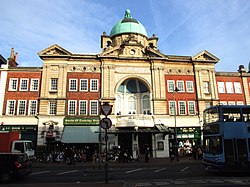History
Construction was completed in 1902 to designs by architect John Priestley Briggs. [2] When it was opened, it had a capacity of 1,100. In 1913, the Opera House hosted a series of charity fundraising concerts gather funds to rebuild the Nevill Ground's cricket pavilion after the original pavilion was destroyed in a suffragette arson attack. [3] The Opera House was purchased by Union Cinemas in 1931 and turned into a cinema. [4]
The Opera House was bombed in the Second World War. The bomb did not explode but instead got caught in the proscenium arch above the stage and set fire to the inside of the Opera House, leading to a renovation before eventual re-opening in 1949. [5] It was later turned into a bingo hall in the 1960s after threats to demolish it. [5] [6] In November 1966, the Opera House was granted Grade II listed status. [1]
In 1996, the Opera House was purchased by J D Wetherspoon and was turned into a public house. [2] In 2006, the Opera House again hosted an opera performance, of Handel's Tamerlano . [7] More recently there have been annual performances by Kent-based ‘The Merry Opera Company’ with Troy Boy, La traviata , The Magic Flute , Kiss Me, Figaro!, [8] The Barber of Seville, and in 2016, La Boheme. [9]
This page is based on this
Wikipedia article Text is available under the
CC BY-SA 4.0 license; additional terms may apply.
Images, videos and audio are available under their respective licenses.


